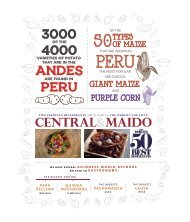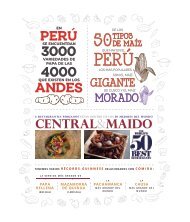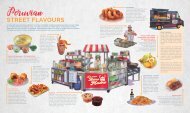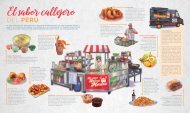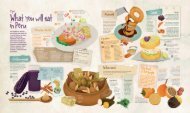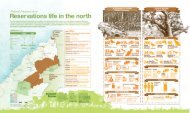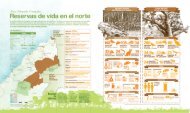UJ #17 - Traditional Peru
You also want an ePaper? Increase the reach of your titles
YUMPU automatically turns print PDFs into web optimized ePapers that Google loves.
Diego Nishiyama<br />
THERE ARE CERTAIN DANCES THAT ARE<br />
SPECIFICALLY PERFORMED DURING<br />
CHRISTMAS CELEBRATIONS, LIKE THE<br />
‘LOS NEGRITOS’ FROM HUÁNUCO, THE<br />
‘HATAJO DE NEGRITOS’ FROM CHINCHA,<br />
AND THE ‘NAVIDAD DE CHIHUA’ FROM<br />
AYACUCHO.<br />
Some of the<br />
figures sold<br />
by artisans<br />
represent Cusco’s<br />
typical dances.<br />
complete, beautiful and detailed piece. These creations<br />
are Andean adaptations of the San Marcos boxes, which<br />
were made during Colonial times with images of the<br />
saints, and used by priests in attempts to convert the local<br />
indigenous population. It wasn’t until the 1940’s however<br />
that inhabitants of the town of Quinua started to create<br />
retablos inspired by these boxes, representing day to day<br />
events (dances, agricultural labour), as well as important<br />
religious moments (Christ’s Crucifixion, the birth of Jesus).<br />
The retablos are made from cedar wood in order to ensure<br />
the best finishes, and feature two beautiful doors, usually<br />
decorated with colourful flowers. Behind the doors, the<br />
people are carved and arranged, painted with detailed<br />
faced and specific clothing. Each detail is carefully thought<br />
out and worked, and the faces and garments depicted<br />
reflect their Andean origin.<br />
Then, there is the jungle and its traditions. In the Amazon,<br />
‘jungle style’ mangers are decorated with straw and<br />
wood, as well as banana leaves, flowers, and fruits. Here,<br />
children are the protagonists of local traditions, as they<br />
spend the days previous to Christmas dressing up as little<br />
shepherds and making their way from house to house in<br />
order to appreciate their neighbours nativity decorations.<br />
With each visit, children are given bags full of candy or a<br />
sweet corn beverage upon their departure. When they<br />
are finished inspecting each home, they come together<br />
with a committee of adults and decide which home has<br />
the best decorations, presenting a prize to the winners.<br />
The famous nativity processions are also typical in some<br />
regions of the jungle where neighbours organize amongst<br />
themselves to dress up as the characters of the nativity<br />
scene and the bible, and walk through the streets towards<br />
the star of Bethlehem. As they walk, musicians play local<br />
songs, creating a festive ambiance for both participants<br />
and spectators.<br />
And what would Christmas be without the ever-anticipated<br />
Christmas Eve meal? <strong>Peru</strong>’s plethora of ingredients provides<br />
a rich banquet of options. In the jungle, the traditional<br />
meal stars chicken rather than turkey, while in the Andes<br />
suckling pig takes the spotlight. In the north of the country,<br />
Chicha – traditional fermented corn beer – is consumed<br />
in the place of champagne, and paneton is replaced by<br />
guaguas – breads with filling, shaped like babies.<br />
Celebrating Christmas in <strong>Peru</strong> is an interesting way to<br />
learn more about local culture and customs, and to<br />
understand the driving force behind the festivities: family<br />
and reflection.<br />
79






